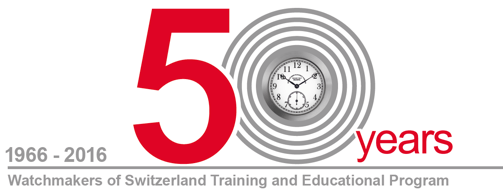Many passionate fans of high watchmaking have likely heard of WOSTEP, however few know what this cryptic acronym really means.
WOSTEP is one of those mythical-sounding names spoken with reverence in Switzerland. But what exactly do these six seemingly haphazardly arranged letters mean? “Watchmakers of Switzerland Training and Education Program” is the answer.

Based in Neuchâtel in a low-key building, this institute is often thought of as the MIT of watchmaker education, a sort of “post degree” institute for watchmakers, though its main goal is actually comprehensive watchmaker education. Despite financing that comes from every corner of the watch industry, it is independent and neutral – much like Switzerland’s international status.

WOSTEP building in Neuchâtel
WOSTEP is a non-profit foundation training future professionals to work with watch brands and retailers around the world.
Wostep was born in 1966, when it opened its doors to train American watchmakers. The timing coincides closely with the founding of the AWCI (American Watchmakers-Clockmakers Institute) in 1960, which was established through consolidating previously established guilds and groups in the United States.
By 1970, WOSTEP’s Refresher Course had opened up to watchmakers of every nation, finally becoming a 20-week course by 1977. Courses on complicated watches were added in the 1980s, and the organization had begun offering training sessions all over the world by the end of the decade. Collaboration with partner schools around the world began in 1992.

Maarten Pieters (standing) giving an introductory course to Swiss watchmaking (2008)
Maarten Pieters has headed the reputable school since 2003. Pieters previously worked with Vianney Halter and THA (Techniques Horlogères Appliquées SA, previously a behind-the-scenes supplier of complications and unique pieces as well as a breeding ground for great horological thinkers, now belonging to Carl F. Bucherer).
Pieters, who took over leadership of WOSTEP from Grand Prix d’Horlogerie de Genève jury member Antoine Simonin, is just the third director of the educational institution in its entire history.

A view of Neuchâtel, Switzerland, where WOSTEP is located
In 1995, five of WOSTEP’s partnership schools introduced the “3,000 hour program,” which just one year later became an official part of horological training in Switzerland.
Demonstrating its international appeal, by 2002 WOSTEP was offering courses in four languages for watchmakers, instructors, and salespeople.
The boom years in watchmaking didn’t pass by WOSTEP unnoticed, with the school boasting countless supporting members including representatives of leading watch brands, independents with complicated specialties, movement manufacturers, retailers in Switzerland and abroad, watchmaking organizations, allied trades, and firms that manufacture electronic and workshop equipment, spare parts, and tools.
Members are at a great advantage in picking out new talent because they are provided with information on the fresh graduates, which makes WOSTEP to Swiss watchmaking what the university and draft systems are to the national football and basketball leagues in the United States – a good way to become aware of and scope out talent.
Today, the 3,000 hour program remains the standard for full training. “3,000 hours permit us to ensure that the bases are well learned,” Pieters told me a few years ago, stressing that 2,400 of these hours are spent with practical use. “Watchmaking is a profession that needs a lot of practical hours and a lot of repetition at the beginning to ensure minimum understanding.”
The curriculum covers the topics of micro mechanics (in other words, making such elements as stems or pivot gauges), mechanical watches, chronographs, electronic watches, and organization of after-sales service.

A view of Lake Neuchâtel
In answer to the question as to why another watchmaking school might want to partner with WOSTEP, Pieters replies that there are a number of advantages: continual up-to-date training of instructors, pedagogic kits, enlarged escapement models for use with students, technical documentation and textbooks provided, organization of exams, and – perhaps the most important point – the successful watchmaker receives a WOSTEP certificate at the end, which is a guarantee of a certain quality for prospective employers.
Currently, WOSTEP offers full training courses for beginning watchmakers and sales and administrative staff. But what most people come to WOSTEP for is further education: a full seven topics can be taken as courses, hitting themes as complicated as escapements and chronographs and as basic as teaching teachers how to teach and metallurgy. These latter types of courses extend in range from two days to 20 weeks.
In 2016, WOSTEP turns 50 years old: happy birthday to this fine institution!
For more information, please visit www.wostep.ch.
Leave a Reply
Want to join the discussion?Feel free to contribute!

My wife and I took the train from our ski villa in Murran and arrived on the doorstep of the WOSTEP school unannounced. They could not have been more gracious when it was discovered I was a graduate of the Watch Technical Institute in Seattle. Maarten was busy but one of the instructors gave us a royal tour. It is a fabulous facility in a gorgeous setting. Behind the school is the library and book store of Antoine Simonin. We spent a couple of hours visiting and touring the library. What a wonderful memory.
Myself and 10 other watchmakers had the benefit of advance watchmaking training by Mr, Andre Farine in 1972. We cannot thank enough all of the watch manufacturers in Switzerland for sponsoring this progam. In and out of the class, we had the time of our lives in Neuchatel. Thank you.
Was there in 95 before they moved to the building there in now! Jan 95! Had what now on when look back was best time in my life!